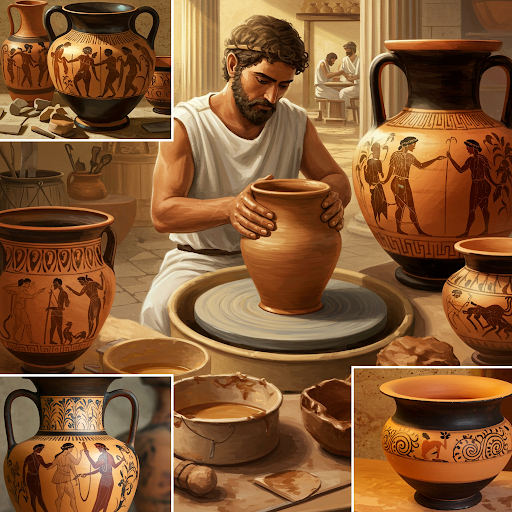Introduction
Pottery played a crucial role in ancient Greek society, serving both functional and artistic purposes. Greek vases, amphorae, and kraters were used for storing liquids, conducting rituals, and telling stories through intricate painted designs. This article explores the different types of Greek pottery, the techniques used in their creation, and the symbolic meanings behind their decorative motifs.
Types of Greek Pottery
Greek pottery varied in shape and function, with different vessels designed for specific uses. Some of the most notable types include:
Amphora
Used for storing and transporting wine, oil, and grains.
Characterized by two handles and a narrow neck.
Krater
A large bowl used for mixing wine and water at symposiums (drinking parties).
Often depicted social and mythological scenes.
Kylix
A shallow drinking cup with horizontal handles.
Frequently adorned with playful or mythological imagery inside the bowl.
Lekythos
A small flask used for storing perfumes and oils.
Commonly found in funerary contexts.
Hydria
A water jar with three handles.
Used for carrying and pouring water in households.
Greek Pottery Techniques
Greek potters developed advanced methods for shaping and decorating their ceramic wares. The two most prominent painting styles were:
Black-Figure Technique (7th–5th Century BCE)
Figures were painted in black slip on a red clay background.
Details were incised into the black areas to reveal the underlying clay.
Popular themes included mythological battles, gods, and heroic exploits.
Red-Figure Technique (5th–4th Century BCE)
The process was reversed: figures remained in red while the background was painted black.
Allowed for greater detail and a more naturalistic portrayal of the human form.
Favored by artists like Euphronios and the Berlin Painter.
Symbolism in Greek Pottery
Greek pottery was more than just decorative; it served as a visual medium to convey cultural, religious, and social messages.
Mythological Themes
Stories of gods and heroes, such as Heracles’ labors and the Trojan War, reinforced cultural identity and moral lessons.
Funerary Imagery
Lekythoi often depicted scenes of mourning, the journey to the underworld, or offerings to the deceased.
Everyday Life Depictions
Scenes of athletic competitions, symposiums, and weddings offered insight into Greek customs and values.
Religious and Ritualistic Symbolism
Some vases were dedicated to deities, depicting Dionysian festivities or temple rituals.
Legacy and Influence
Greek pottery influenced later artistic traditions, particularly in the Roman world and the Renaissance. Today, these artifacts provide historians and archaeologists with invaluable insights into ancient Greek life, beliefs, and artistic achievements.
Conclusion
The pottery of ancient Greece was not merely utilitarian; it was an artistic expression that captured the essence of Greek civilization. The evolution of pottery techniques and the rich symbolism embedded in their designs continue to fascinate scholars and art enthusiasts alike, preserving the legacy of ancient Greece for future generations.









